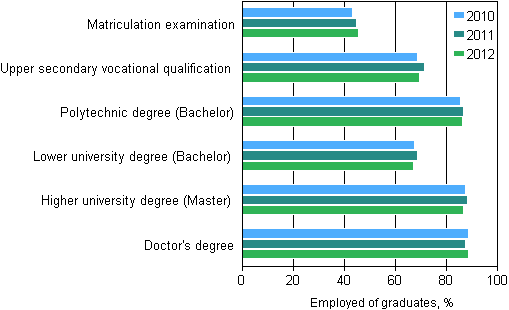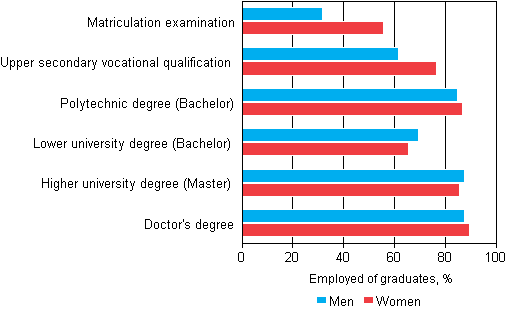Published: 12 February 2014
Finding employment became slightly more difficult for recent graduates
According to Statistics Finland, transition to work was somewhat more difficult for recent graduates in 2012 than in the previous year. In all, around 70 per cent of those with upper secondary vocational qualifications were employed, which was two percentage points lower than the year before. Transition to work also deteriorated slightly among those with university degrees. Eighty-seven per cent of both those with polytechnic degrees and higher university degrees found employment. Employment improved only for doctors, rising to 89 per cent.
Employment of graduates one year after graduation by level of education 2010–2012, %

Employment among recent graduates is measured one year after their graduation. Of all recent graduates, 69 per cent were employed, 17 per cent were studying while working and 14 per cent were full-time students; this was so for 37 per cent of the passers of the matriculation examination and for 31 per cent of those with lower university degrees. More information related to direct transition to futher studies of passers of to marticulation examination is available from statistic describing Entrance to education .
The proportion of unemployed persons grew in nearly all levels of education. Of all recent graduates, the proportion of unemployed was eight per cent. At close on 14 per cent, the proportion of the unemployed was the highest among attainers of upper secondary vocational qualifications. Nearly seven per cent of the graduates from polytechnics and close on six per cent of the graduates with higher university degrees were unemployed.
Men's transition to working life grew more difficult by two percentage points. Women found employment more easily than men did. The proportion of employed women was 13 percentage points higher than that of men. Of all recent graduates, 62 per cent of men and 75 per cent of women were working. The rate of employment was 62 per cent for men and 77 per cent for women among attainers of vocational qualifications. Eighty-five per cent of men and 87 per cent of women with polytechnic degrees were employed. Eighty-eight per cent of men and 86 per cent of women with higher university degrees had found jobs.
Employment of graduates one year after graduation by sex and level of education 2012, %

There were differences in the transition to working life by field of education. Compared to the year before, employment deteriorated most among graduates from the field of technology and transport, by around four percentage points. Unemployment among graduates from the field of technology and transport was already close to 15 per cent. The transition was smoothest for attainers of qualifications in the fields of safety and security, welfare, health and sport. Their employment rate was over 89 per cent. In all fields of education, the transition was easier for those with university degrees than for those with upper secondary qualifications. At nearly 20 per cent, the rate of unemployment was highest for those with upper secondary qualifications in the field of natural sciences.
Examined by region, the rate of employment among recent graduates varied from 84 per cent in Åland to 59 per cent in North Karelia. Besides Åland, the rate of employment was higher than the average for the whole country in the regions of Uusimaa, Kanta-Häme, Ostrobothnia and Central Ostrobothnia.
Source: Education 2014. Statistics Finland
Inquiries: Anna Loukkola 09 1734 3678, koulutustilastot@stat.fi
Director in charge: Riitta Harala
Publication in pdf-format (238.3 kB)
- Tables
-
Tables in databases
Pick the data you need into tables, view the data as graphs, or download the data for your use.
Appendix tables
- Figures
Updated 12.2.2014
Official Statistics of Finland (OSF):
Transition from school to further education and work [e-publication].
ISSN=1798-9469. 2012. Helsinki: Statistics Finland [referred: 7.1.2026].
Access method: http://stat.fi/til/sijk/2012/sijk_2012_2014-02-12_tie_001_en.html

